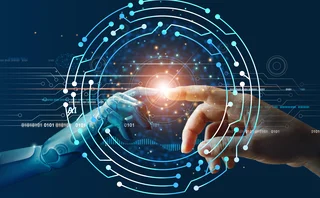The Need for Speed: Being the Fastest Will Always be Sought After
Anthony ties the movie Top Gun to HFT, IoT and AI...naturally.

May 13 marked the 30th anniversary of the release of Top Gun. If you’re not familiar with that movie, I’m not going to explain it to you since I don’t think we can be friends anyway. Just skip ahead to paragraph three.
The film is a quote machine: “I flew with your old man,” “Tower, this is Ghost Rider requesting a flyby,” “Take me to bed or lose me forever,” and “You can be my wingman anytime,” to name a few. But probably most iconic is Maverick (Tom Cruise) saying: “I feel the need …” followed by Maverick and his co-pilot Goose (Anthony Edwards) in unison exclaiming, “… The need for speed!”
Having re-watched Top Gun last month for the 1,284th time, those quotes were stuck in my head. So when I read this headline—“Latency Key but No Longer Killer”—in Waters’ sibling publication Inside Market Data, my curiosity was piqued.
In my six-plus years at Waters, I’ve found the “speed” issue to be fascinating. Everybody wants speed, but events like the Flash Crash and books like Michael Lewis’ Flash Boys have caused some firms to curb their enthusiasm, at least in public statements. And there are serious cost pressures; when we’re talking about nanoseconds and picoseconds, how much are you really willing to spend to get that edge?
At this year’s North American Financial Information Summit (Nafis), co-hosted by Inside Market Data and Inside Reference Data, there was a panel that addressed Wall Street’s need for speed. As reported on by IMD’s Joanne Faulkner, the consensus during the panel was that being able to make the right decisions in a timely fashion will give firms a greater competitive advantage than building an ultra-low-latency trading environment.
Power thrills, but speed kills. That will never change. What I am certain about is that speed will mesh quite nicely with IoT and AI.
Philippe Burke, managing partner at London-based asset manager Apache Capital, said that the firm “would prefer to do something quickly if we can; if we can do them more quickly than others, that’s great. But the most important thing is that the trade is the right one.”
Blast the markets with trades or snipe the market with trades—it’s a tricky subject. I think there are plenty of quant shops in Chicago—and even some hedge funds in New York—that would not be so quick to concede the speed crown. But Burke’s point is a good one: How much are you willing to spend to be the fastest? Isn’t it better to find value elsewhere?
Another comment Burke made touched on two things that I’ve been rambling on about for a good year now. From Faulkner’s article: “If all we’re doing is analyzing the standard time-series ... there are hundreds of people doing that. You need to ask, ‘What can I do that’s different?’” Burke said, suggesting that perhaps it would be more advantageous to use satellite imagery to analyze the amount of heat rising from corn fields, and correlate that to the crop yield expected from that field in 90 days’ time. For someone trading corn futures, finding that new data source and correlating it to supply could provide a trading edge “over and above what I might be able to get by being a little faster,” he added.
Enter IoT and AI
Some of what Burke talks about rests in the promise of the Internet of Things (IoT). As the world becomes increasingly “sensorized,” a tsunami of information will be created that humans can use to make more intelligent decisions—both for our betterment (i.e., airplane safety) and for our profit (i.e., using sensors to better predict crop yields). But humans won’t be able to do this alone; we will need to deploy artificially intelligent platforms, and, specifically, turn to machine learning to handle this sea of data.
Everyone will win, right? I don’t think so. Those speed-happy firms that have made monster investments in low-latency platforms are better equipped to quickly capitalize on IoT and machine-learning developments. There’s no reason to think they won’t be fast and smart. Power thrills, but speed kills. That will never change. What I am certain about is that speed will mesh quite nicely with IoT and AI.
You think I’ve got it wrong? Well, talk to me, Goose! If anything, we can discuss what we think Tom Cruise’s role will be in Top Gun 2.
Only users who have a paid subscription or are part of a corporate subscription are able to print or copy content.
To access these options, along with all other subscription benefits, please contact info@waterstechnology.com or view our subscription options here: http://subscriptions.waterstechnology.com/subscribe
You are currently unable to print this content. Please contact info@waterstechnology.com to find out more.
You are currently unable to copy this content. Please contact info@waterstechnology.com to find out more.
Copyright Infopro Digital Limited. All rights reserved.
As outlined in our terms and conditions, https://www.infopro-digital.com/terms-and-conditions/subscriptions/ (point 2.4), printing is limited to a single copy.
If you would like to purchase additional rights please email info@waterstechnology.com
Copyright Infopro Digital Limited. All rights reserved.
You may share this content using our article tools. As outlined in our terms and conditions, https://www.infopro-digital.com/terms-and-conditions/subscriptions/ (clause 2.4), an Authorised User may only make one copy of the materials for their own personal use. You must also comply with the restrictions in clause 2.5.
If you would like to purchase additional rights please email info@waterstechnology.com
More on Emerging Technologies
BlackRock tests ‘quantum cognition’ AI for high-yield bond picks
The proof of concept uses the Qognitive machine learning model to find liquid substitutes for hard-to-trade securities.
JP Morgan, Eurex push for DLT-driven collateral management
The high-stakes project could be a litmus test for the use of blockchain technology in the capital markets.
For AI’s magic hammer, every problem becomes a nail
A survey by Risk.net finds that banks are embracing a twin-track approach to AI in the front office: productivity tools today; transformation tomorrow.
On GenAI, Citi moves from firm-wide ban to internal roll-out
The bank adopted three specific inward-facing use cases with a unified framework behind them.
How a Chinese AI firm shook the tech world
DeepSeek’s AI model is the very ethos of doing what you can with what you have.
To unlock $40T private markets, Hamilton Lane embraced automation
In search of greater transparency and higher quality data, asset managers are taking a tech-first approach to resource gathering in an area that has major data problems.
Waters Wavelength Ep. 304: Nice Actimize’s Lee Garf
Lee joins to discuss changes in communication platforms over the last few years.
DTCC revamps data distribution, collection efforts with cloud, AI
The US clearinghouse is evaluating the possibilities that cloud and AI offer to streamline the processes by which it collects and makes data available to market participants.








